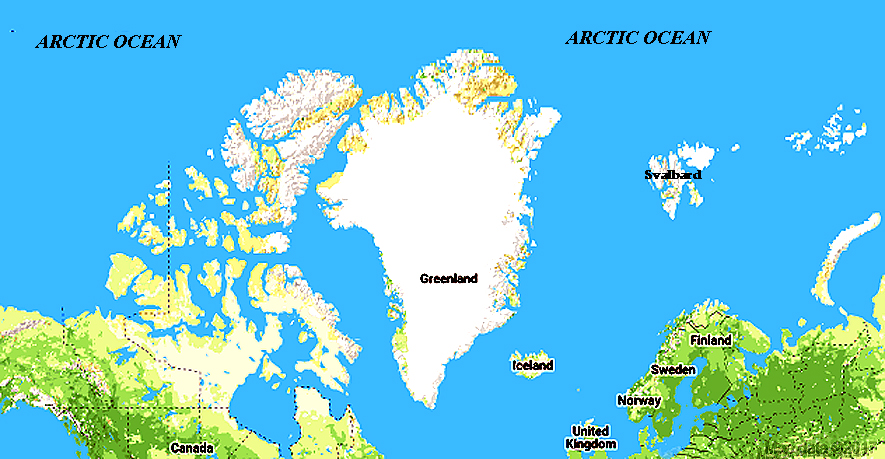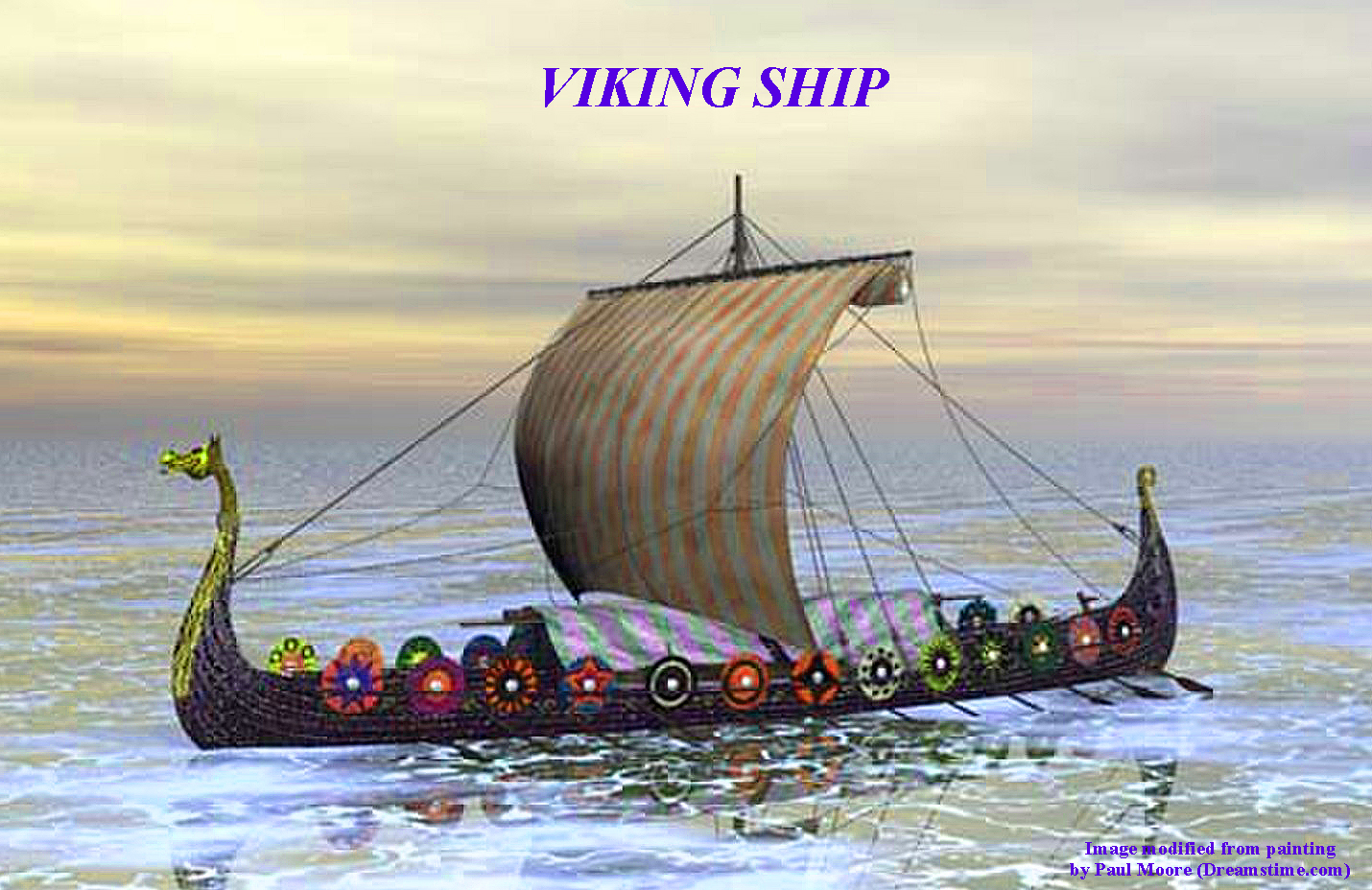File: <Greenland History.htm> Archeology Index Viking Index <American Archeology> <Home>
|
For teaching purposes; Quote cited references when available Ancient Emigrations To America |
|
GREENLAND
HISTORY (Contact) Please CLICK on following
subjects for details & images to enlarge Greenland
history is a life under extreme Arctic conditions. In 2017 an ice cap still
covers over 70 percent of the island, which confines human activity largely
to the coasts. The first
people are believed to have arrived in Greenland around 2500 BCE. Their
descendants may have died out and were succeeded by several other groups
immigrating from continental North America.
There has been no evidence that The
earliest known cultures in Greenland are the Saqqaq
Culture (2500–800
BCE) and the Independence I Culture in northern Greenland (2400–1300 BCE). These two cultures are believed to have
descended from separate groups that came to Greenland from northern
Canada. Around 800 BCE, the so-called
Independence II
Culture arose
in the region where the Independence I
Culture had previously existed. The Independence
II Culture may have been succeeded by an early Dorset Culture (700 BCE to 1 AD), but some Independence II artifacts
date from as recently as the 1st century BCE. Archeological studies suggest that in Greenland the Dorset Culture may be a continuation of
the Independence II Culture;
the two cultures have thus been called "Greenlandic
Dorset". Artefacts
associated with early Dorset Culture
in Greenland are found as far north as Inglefield
Land on the west coast and the Dove
Bugt area on the east Greenland coast. After the
Early Dorset Culture
disappeared by around 1 AD, Greenland was apparently uninhabited until Late
Dorset people settled on the Greenlandic side of the Nares Strait around 700. The late Dorset
Culture in the north of Greenland endured until about 1300. Meanwhile the Norse arrived and settled
in the southern part of the island in 980. = = = = = = = = = = = = = = = = = = = = = = = = = Europeans
became aware of Greenland's existence, probably in the early 10th Century,
when Gunnbjörn Ulfsson, sailing from Norway to Iceland, was carried there by
a storm. He found some islands off
the mainland. During the 980s, explorers
The Norse
established their settlements along fjords (such as the Tunuliarfik and Aniaaq fjords in the central area of the
Eastern settlement). Because this was
during a Medieval Warm Period
when the vegetation there was more abundant from what it is in the 21st
Century. Excavations reveal that the
fjords at that time were surrounded by forests of 4 to 6 metre tall birch
trees and by hills covered with grass and willow brush. The Norse probably cleared the landscape
by felling trees to use as building material and fuel, and by allowing their
sheep and goats to graze in both summer and winter. According
to the sagas, Erik the Red was
exiled from Iceland for three years for committing murder. He sailed to Greenland, where he explored
the coastline and claimed certain regions as his own. He then returned to Iceland to persuade
people to join him in establishing a settlement on Greenland. The Icelandic sagas reveal that 25 ships
left Iceland with Erik the Red in
985 AD, and that only 14 of them arrived safely in Greenland. This date has been approximately confirmed
by radiocarbon dating of remains at the first settlement at Brattahlid (now
Qassiarsuk, which yielded a date of about 1000 AD. According to the sagas, it was also in the year 1000 AD that
Erik's son, Leif Eirikson, left
the settlement to explore the regions around Vinland,
which included Newfoundland and some Midwestern North
American areas. = = = = = = = = = = = = = = = = = = = = = = = = = The Saqqaq Culture (named after a Saqqaq
settlement that is the site of many archaeological finds) was a Paleo-Eskimo Culture in Greenland. The earliest
known culture in southern Greenland, the Saqqaq
Culture, existed from around 2500 BCE until about 800 BCE. This culture coexisted with the Independence I Culture of northern
Greenland, which developed around 2400 BCE and lasted until about 1300 BCE. After the Saqqaq
Culture disappeared, the Independence
II Culture of northern Greenland and the Early Dorset Culture of West Greenland
emerged. The timeframe of the
transition from Saqqaq Culture
to Early Dorset in western Greenland is not definitely known. In the
northeastern part of Greenland, the culture is designated "Independence I" while in the
western part of Greenland, it is the
"Saqqaq Culture". The Saqqaq
Culture came in two phases, the main difference of the two being
that the newer phase used sandstone
as a tool. The younger phase of the Saqqaq Culture coincides with the oldest
phase of the Dorset Culture. Frozen
remains of a Saqqaq called "Inuk"
were found in western Greenland (Qeqertarsuaq) and have been DNA sequenced. He had brown eyes, black hair, and
shovel-shaped teeth. It was
determined that he lived about 4000 years ago, and was related to native
populations in northeastern Siberia.
The Saqqaq people are not the ancestors of contemporary Kalaallit people, but instead are
related to modern Chukchi and Koryak peoples. It is unclear whether they came to
Greenland in boats or by traveling over the frozen sea during winter. Saqqaq
peoples were adapted to extremely cold climates. During the warmer parts of the year they lived in small tents
(like the later Thule people) and hunted
seals, seabirds, and other marine animals. The people of the Saqqaq Culture used silicified slate, agate,
quartzite, and rock crystals as materials for their tools. = = = = = = = = = = = = = = = = = = = = = = = = = The Independence I Culture was a Paleo-Eskimo culture of peoples who
lived in northern Greenland from 2,400 to 1,000 BCE. It is named after Independence Fjord. They lived at the same time as the Saqqaq Culture of southern
Greenland. The Independence II Culture had a similar
geographical distribution from the 8th Century BCE, about 600 years after the
disappearance of Independence I. Nevertheless, the Independence I occupation of northern
Greenland seems to have been much more intensive than that Independence II. The
archaeological finds of both Independence
cultures are credited to Danish explorer Eigil
Knuth. = = = = = = = = = = = = = = = = = = = = = = = = = The Dorset Culture (also called the Dorset Tradition) was a Paleo-Eskimo culture (500 BCE to between
1000 and 1500 AD) that preceded the Inuit
in the Arctic of North America. It is
named after Cape Dorset in
Nunavut, Canada where the first evidence of its existence was found. The culture had four phases according to
differences in the technologies for hunting and tool making. Artifacts include distinctive triangular
end-blades, soapstone lamps, and burins. The Dorset were first identified as a separate
culture in 1925. The Dorset may have become extinct by 1500
AD at the latest and perhaps as early as 1000 AD. The Thule people, who began
emigrating east from Alaska in the 11th Century, spread through the lands
previously inhabited by the Dorset. However, there is little evidence that the
Inuit
and Dorset ever met. Modern genetic studies reveal that the Dorset population was distinct from
later groups and there was virtually no evidence of genetic or cultural
interaction between the Dorset and the Thule
peoples. Inuit
legends recount them encountering people they called the Tuniit
(singular Tuniq or Sivullirmiut ) "First Inhabitants". According to legend, the First Inhabitants were giants, taller
and stronger than the Inuit but
afraid and not sociable. It is
believed that the Dorset and
the later Thule
people were encountered by Norsemen who visited the area. The Norse called these indigenous peoples Skrælings. Apollonio, Spencer. 2008.
Lands That Hold One Spellbound: A
Story of East Greenland. University of Calgary Press. p. 283 Byock, Jesse. 1988.
Medieval Iceland: Society, Sagas
and Power. University of
California Press. Fagan, Brian M.
2005. Ancient North America: The Archaeology
of a Continent (Fourth ed.).
New York: Thames & Hudson.
pp. 196–97, 210 Ford, James.
1959. Eskimo prehistory in the vicinity of
Point Barrow, Alaska Anthropological Papers of the American
Museum of Natural History.
New York. 47 (1). Hjálmarsson, Jón R. 2009. History of Iceland:
From the Settlement to the Present Day. Reykjavik: Forlagið Publishing. Jensen, J. F. 2016.
Greenlandic Dorset . In M. Friesen and O. Mason. The Oxford
Handbook of the Prehistoric Arctic. Laursen, Dan. 2016.
Eigil Greve Knuth (1903-1996)
, Arctic, University of Calgary, Vol.
49, No. 4, pp. 401-403. Lidegaard,
Mads. 1981. Eigil Knuth. Dansk Biografisk Leksikon, vol. 8 (Copenhagen), Maanasa Raghavan,
Eske Willerslev, et al.
2014. The genetic prehistory
of the New World Arctic. Science. 345
(6200): 1020. McGhee, Robert. 2001.
Ancient People of the Arctic. Canadian Museum of Civilization. UBC
Press. p. 31. Mowat, Farley. 1973.
Westviking: The Ancient Norse in Greenland and North America. Funk & Wagnalls Co. O'Carroll, Etain.
2005. Greenland and the
Arctic. Lonely Planet. p. 180. Park, Robert W.
2014. Stories of Arctic
colonization. Science. 345 (6200): 1004–05. Ramsay, Raymond. 1972.
Appendix II: Sunken Islands near
Iceland. No Longer on the Map. New York: Viking Press. pp. 246–7. Rasmussen, M; et al.
2010. Ancient human genome sequence of an
extinct Palaeo-Eskimo.
Nature. Nature Publishing Group. 463 (7282):
463, 757–762. Sanders, Ruth. 2010. German: Biography of
a Language.
Oxford University Press. p. 209. Seaver, Kristen A. 1996. The
Frozen Echo. Stanford
University Press. Seaver, Kirsten A.. 2014. The Last
Vikings: The Epic Story of the Great Norse Voyagers. I.B.Tauris Publ. Smiley, Jane. The Sagas of the Icelanders. Deluxe. New York: Penguin Group, 2000.
653–74. Vikør, Lars S. 1993.
The Nordic Languages. Their Status and
Interrelations.
Oslo: Novus Press. pp. 55–59, 168–169, 209–214. Watson, A.D.
1923. The Norse Discovery of America.
Journal of the Royal Astronomical Society of Canada. 17: 260. |

